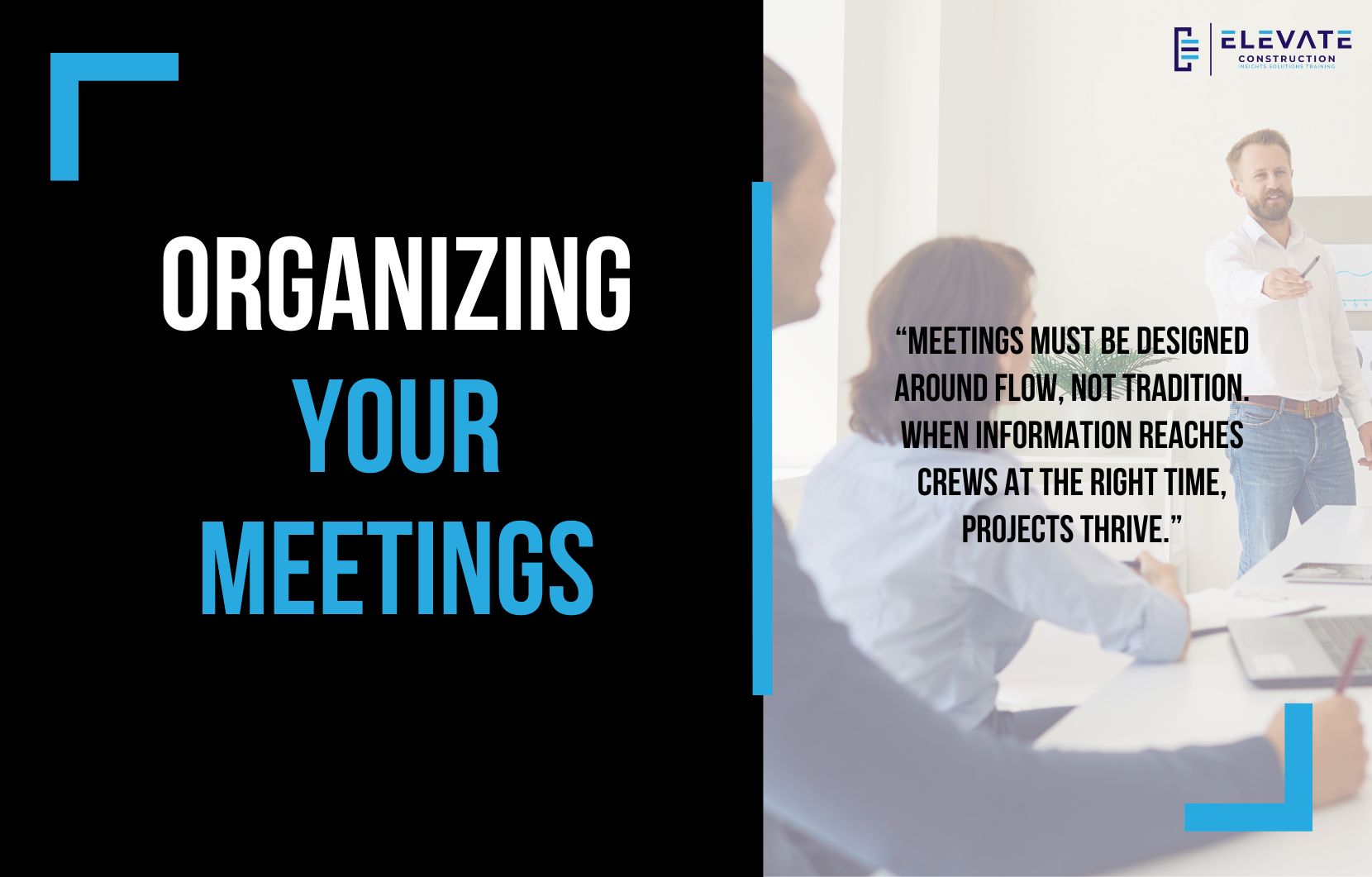Building Flow into Your Meeting System
Meetings are one of the most challenging parts of construction projects. They can either waste time or create the flow of information your team needs to succeed. Recently, I worked with a client facing a complex job with difficult phasing. Their team had plenty of meetings in place, but they were struggling to get information to the field in a way that truly supported the work.
The first instinct for most teams is to list the meetings they already have: coordination, owner’s meetings, and local leadership check-ins. But that approach misses the bigger question. Instead of asking which meetings exist, we need to ask how information flows to the field.
When I reframed the question, the group realized their system was backward. They were focusing on agendas and historical habits rather than flow. That was the turning point.
From Meetings to Flow
Here is how information needs to move in a lean meeting structure. First, the team needs time to organize, balance responsibilities, and ensure coverage. Without this step, people cannot plan or execute effectively. Next comes strategic planning and aligning procurement. This step ensures the big picture is clear.
From there, the trade partners get involved. Pull planning, look-ahead planning, and weekly work planning are the heartbeat of collaboration. Once those are established, the plan should be reviewed with the client in the field, adjusted as needed, and then taken into the OAC meeting for reporting. Finally, everything cascades into daily huddles with foremen and workers.
This sequence may sound simple, but it flips the traditional approach. Instead of working from standing agendas, you design meetings around the natural flow of information and permissions.
The Breakthrough
With the client team, I drew out a three-week timeline and asked when meetings should happen to create flow. That question sparked the breakthrough. Suddenly they saw it. Team planning on Thursday afternoon, trade partner meetings on Monday morning, client field check-in Monday afternoon, OAC on Tuesday, and then weekly work plan execution followed by daily huddles.
This system created clarity. Instead of isolated meetings, the team now had a rhythm that carried information from leadership to the foreman and ultimately to the workers. We went on to design agendas, visuals, and deliverables for each step. By the end, the group could see how their meetings were supposed to be organized and why it mattered.
Why This Is So Hard
Organizing meetings by flow is one of the hardest tasks on a project. Most companies have ingrained habits based on tradition, not on what actually supports the work. It feels natural to schedule meetings around availability, leadership preferences, or company templates. But that creates gaps and delays where information dies before it reaches the field.
True lean meeting systems are built backward from the foreman. The question is always: how do we ensure crews get the right information, permissions, materials, and support at the right time? Every meeting should serve that flow.
A Word on Quality
This idea connects directly to quality management. Having a checklist or a preconstruction preparation process is not enough if it is not followed. Just like a restaurant can repeat back your order multiple times and still get it wrong, a project team can have checklists and still fail if they do not flow the process to the field. Implementation is what counts.
Final Thoughts
Meetings are not about checking boxes or keeping up appearances. They are about designing flow. If your project is struggling with miscommunication, missed deadlines, or repeated issues in the field, take a hard look at your meeting system. Ask whether it is designed around flow or habit.
This is one of the hardest challenges you will face as a construction leader, but also one of the most rewarding. When meetings deliver the right information to the right people at the right time, your project will run smoother, your teams will feel supported, and your workers will succeed.
Key Takeaway
Meetings must be designed around flow, not tradition. When information reaches crews at the right time, projects thrive.
If you want to learn more we have:
-Takt Virtual Training: (Click here)
-Check out our YouTube channel for more info: (Click here)
-Listen to the Elevate Construction podcast: (Click here)
-Check out our training programs and certifications: (Click here)
-The Takt Book: (Click here)
Discover Jason’s Expertise:
Meet Jason Schroeder, the driving force behind Elevate Construction IST. As the company’s owner and principal consultant, he’s dedicated to taking construction to new heights. With a wealth of industry experience, he’s crafted the Field Engineer Boot Camp and Superintendent Boot Camp – intensive training programs engineered to cultivate top-tier leaders capable of steering their teams towards success. Jason’s vision? To expand his training initiatives across the nation, empowering construction firms to soar to unprecedented levels of excellence.
On we go

